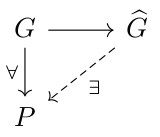TANT 21+22 - What's next?
Hello there! These are notes for the last two classes of the course " Topics in algebra and number theory " held in Block 4 of the academic year 2017/18 at the University of Copenhagen . In the latest classes of the course we have struggled with understanding class field theory , which is the study of abelian extensions of a field. More precisely, given a field \( K \) which is either finite, local or global we can define a group \( C_K \) by setting \[ C_K := \begin{cases} \mathbb{Z}, \ \text{if} \ F \ \text{is finite} \\ K^{\times}, \ \text{if} \ F \ \text{is local} \\ \mathbb{I}_K/K^{\times}, \ \text{if} \ F \ \text{is global} \end{cases} \] and class field theory gives us an Artin map \( \theta_K \colon C_K \to G_K^{\text{ab}} \), where \( G_K \) is the absolute Galois group of \( K \). We know moreover that this map has some functoriality property when we change the field \( K \), and that the map \( \widehat{\theta_K} \colon \widehat{C_K} \to G_K^{\text{ab}} \) is a






